The Abbott mercury mine and mill are situated at an elevation of 2,000 feet in Lake County, California, approximately 24 miles west of Williams on State Highway 20 towards Clear Lake. Williams, which is served by the Southern Pacific railroad, is a local supply point as well as Colusa, located 10 miles east of Williams on State Highway 20.
History
The mine was discovered in 1862 and made its first recorded production in 1870. Operation of the mine has been interrupted by periods of low mercury markets and by an interval of litigation. The four main productive periods have been 1870-1879, 1889-1906, 1941-1946, and 1952 to the present. Total production is in excess of 50,000 flasks (76 pounds) which ranks it about tenth among California mercury mines in all-time production. The property was acquired by COG Minerals on August 7, 1958.
Geology
The Abbott ore bodies are contained in dikes and sills of serpentine breccia which make up a northwest trending complex some 2½ miles long and from 275 feet to 2,500 feet wide. This breccia was intruded cold into lower Cretaceous sediments on the southwest flank of the Wilbur Springs anticline. On the southwest or hanging wall side of the serpentine, and in the septa between dikes, the sediments consist almost exclusively of shale. The mineralizing solutions were confined by the shale and by stretches of flat dip or other favorable structural traps that provided the impedance necessary to localize the scattered ore bodies.
Cinnabar is the predominant ore mineral. It is found in a variety of forms varying from solid veinlets and irregular masses to scattered crystals. Metacinnabar is sometimes found but it is a minor accessory ore mineral. Iron sulfide (marcasite) occurs in and near the ore bodies. The gangue includes carbonates, opal, and other siliceous minerals which replaced the serpentine and hosted the ore bodies. Solid and liquid hydrocarbons are occasionally present. The average ore body consists of about 20,000 tons and contains approximately 12 pounds of mercury per ton.
Mining
Virtually all the mining has consisted of underground operations using five adits and a 500-foot shaft. Most ore bodies are flat-lying in part, badly fractured, and have weak hanging walls of shale which require square setting. Mucking machines are used for the advance of all drifts and crosscuts. Slushers are sometimes required in the flat-lying stopes for scraping the
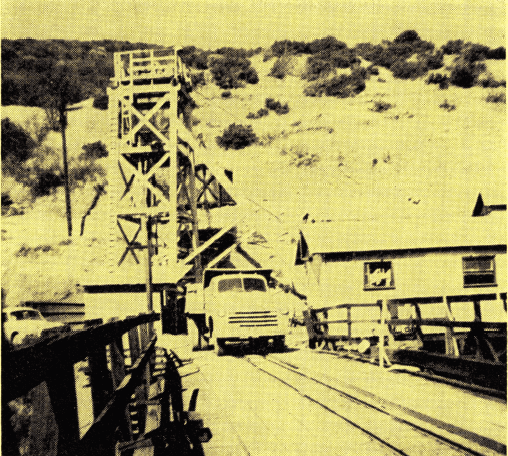
Ore is delivered to the coarse ore bin at the mill by trucks from the nearby adits or by ore cars from the shaft collar. The location of the shaft and headframe is shown together with the trestle to the coarse ore bin. The buildings include the lamp room, foreman’s office, and hoist house.
broken ore to the stope chutes. Track haulage is employed using battery trammers in the drifts and crosscuts.
Constant exploration and development is necessary because of the dispersed nature of the ore bodies. Surface and underground diamond drilling is utilized in certain areas.
Power
For many years all power was generated at the property using diesel-generator sets, but in 1959 a 10-mile power line (12 KV) was constructed by the company to furnish the operation with public power from the Pacific Gas and Electric Company.
A 92.5 KVA Caterpillar diesel-generator set is available for emergency power in the event of power
failure.
Water
Domestic water for the bunkhouses, boarding house, residences, mill, and office is supplied by wells. Mine water is utilized for the mining and milling operations. Only a limited amount of water is needed for the mill since the ore is furnaced directly without prior beneficiation.
Milling
The mill is located adjacent to the main shaft and consists of a 70-ton per day conventional-type furnace plant in which the crushed ore is heated in rotary furnaces to vaporize the mercury and the gases condensed for recovery of prime virgin mercury. The mill was constructed in 1940.
CRUSHING — The run-of-mine ore is delivered to the coarse ore bin by either ore cars servicing the collar of the main shaft or trucks from the nearby adits. The ore is fed to an 8″ x 15″ jaw crusher powered by a 15 H.P. electric motor and crushed to approximately 1½-inch which is sufficient for direct furnacing after storage in a 150-ton fine ore bin. The crushing plant is built on a steep hillside utilizing gravity rather than conveyors. Both bins are of wood construction.
FURNACING—The fine ore bin is discharged through two gate drawoff points to two 42″ x 50′ Gould-type rotary furnaces operating in parallel and set at a slope of ¾” per foot. The crushed ore is introduced in the furnaces by reciprocating bumper-type pipe feeders (adjustable from 16 to 30 strokes per minute) which prevent the escape of valuable and poisonous mercury vapors. The furnaces operate at one revolution per minute and are powered by variable speed 7½ H.P. electric motors through a chain and gear drive. Furnace linings are flint acid brick and have a life of approximately one year on the fire end and up to five years on the feed end. Each furnace has a capacity of about 35 tons per 24 hours.
The burned ore (calcine) discharges at the burner end and drops into a metal bin for storage and partial cooling prior to haulage to the waste dump. The furnaces are fired by low-pressure Model 783-U Hauck burners using PS-300 oil as fuel. The fuel consumption averages eight gallons per ton of crude ore. The oil is preheated to 200° F. with a 6 KW Hauck electrocoil heater and delivered to the burners by means of a Viking oil pump equipped with a ½ H.P. motor. Air for the burners is produced by a 5 H.P. Hauck turbo blower rated at 565 cfm and 20 psi.
The gases (mercury vapor) are drawn off the feed end of each furnace by separate No. 300 American suction fans operating at 1,800 R.P.M. with 7½ H.P. motors and then pass to Size 11 Sirocco cyclone-type dust collectors. The temperature of the gases is automatically registered by a Tagliabue Graph Recorder just prior to their entry into the suction fans. The gases are maintained between 500° F. and 600° F. at this point.
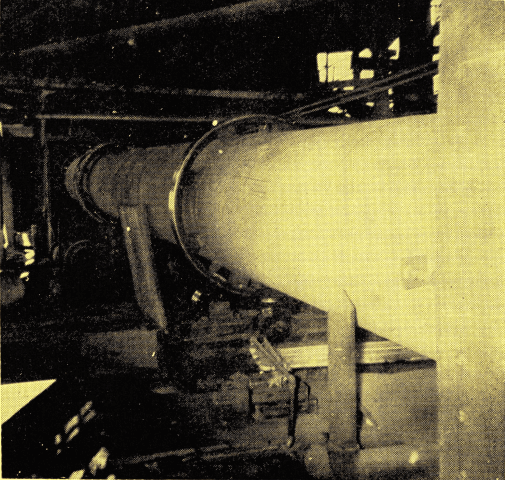
One of the 42″ x 50′ Gould-type rotary furnaces in which the crushed ore is heated to vaporize the mercury. The hot gases containing the vaporized mercury are drawn off the feed end and after passing through a dust collector are sent to the condensers. The burned ore (calcine) discharges at the burner end and is hauled to the waste dump.
The two furnaces operate completely independent of one another and have separate condensing systems which enables the plant to operate at one-half capacity during maintenance periods or in case of ore shortages.
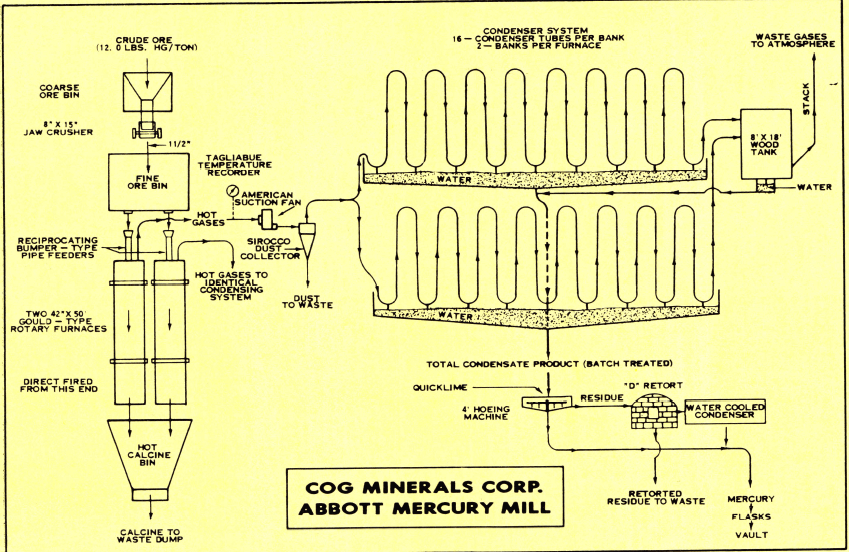
CONDENSING — The gases from each furnace after passing through the dust collectors are split between two banks of condensers. Each bank consists of 16 iron condenser pipes standing vertically and connected with U-shaped cast iron fittings that direct the gases upwards and downwards through the system. The pipes are 12″ in diameter and have a wall thickness of 5/8″. The condenser tubes (pipes) are 12′ and 18′ high, the difference being due to a design preference.
The condenser banks are air tight and in the open which allow the gases to cool during their passage through the system. The condensate as it forms is discharged continually through short outlet pipes on the bottom of the U-shaped fittings connecting each pair of condenser tubes. These outlet pipes are submarged in a water-filled wooden trough which acts as a seal against gases escaping and provides a collection vessel for the mercury-bearing condensate product. The inside of the condenser tubes are washed daily with water from the top, using a hose inserted in a port supplied for this purpose. Most of the condensate product is produced in the middle section of each condenser bank.
The exhaust gases from all condenser banks (both furnaces) are combined in an 8′ by 18′ redwood tank closed at the top. Any condensate formed in this tank is recovered by means of a water-sealed bottom discharge pipe, but the yield is usually very small. All the combined gases from this tank are exhausted to the atmosphere through a 30″ diameter wood stave stack.
The gases as they cool through the condenser tubes become very corrosive and require that the tubes and their U-shaped connectors be replaced about every 12 to 18 months. The life of these parts, however, has been prolonged considerably by using fiberglass-epoxy resin patches. The patches can be applied directly to the hot tubes or connectors as small holes develop without shutting down the plant.
TREATMENT OF CONDENSATE PRODUCT — The condensate product is manually collected once a day. This product, which resembles a dark mud, is batch treated in a mechanical hoeing machine. Quicklime is added to the charge and with the back-and-forth mixing action of the hoeing machine, the mercury is freed, coalesces, and flows to a collecting container placed under the unit. The consumption of quicklime is approximately 5.0 pounds per ton of crude ore feed.
The hoeing machine, which was designed and fabricated at the property, consists of a 4′ round dish-shaped iron pan with 8″ sides. The mixing mechanism consists of one crossarm turning at 30 R.P.M. and equipped with four plows that move the condensate-quicklime
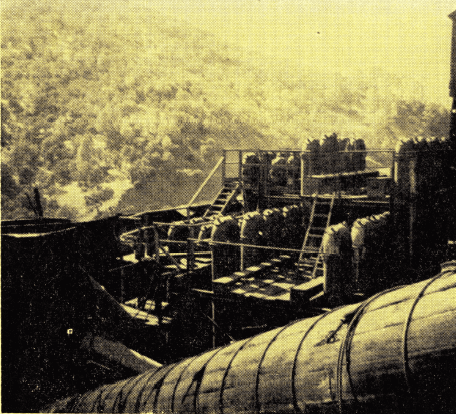
The hot gases from each furnace are cooled through two banks of cast Iron condensers. The mercury-bearing condensate is collected as a mud at the bottom of the condensers. After leaving the condensers, all gases are collected in an 8′ x 18′ redwood tank and then exhausted to the atmosphere through a 30″ diameter wood stave stack.
mixture alternatively to the center and toward the periphery. The unit is powered from underneath by a 5 H.P. electric motor through a gear drive. The hoeing time for each charge is approximately one hour. It is discharged automatically at the periphery by opening a gate. The unit is covered by a hood and operated in the open to minimize the operator’s exposure.
Roughly 85 per cent of the mercury contained in the condensate product is recovered by the hoeing machine. The remaining mercury is recovered by batch retorting the hoeing machine reject in an oil fired D-type retort (1,300° F.) equipped with a water-cooled condenser. The retorted residue is then discarded as waste. Each charge to the retort consists of approximately 200 pounds and requires about 12 hours for completion. The hoeing machine reject can be fed back to the rotary furnaces but the objection to this procedure is the continual build-up of excessive dust in the condenser system and a loss of mercury in the dust collector.
The mercury collected from the hoeing machine and the D-type retort is combined and filtered through a bed of quicklime for removal of any foreign substances prior to temporary storage in a padlocked collecting pot. The accumulated mercury, which is prime virgin mercury of 99.9 per cent plus purity, is periodically drawn from the bottom of the pot directly into standard iron flasks that hold 76 pounds of mercury. Each flask is weighed as it is filled and then stored in a locked vault preparatory to marketing.
Marketing
The chemical trades are the principal consumers, but significant amounts are also used for electrical apparatus, instruments, drugs, paints, amalgamation,
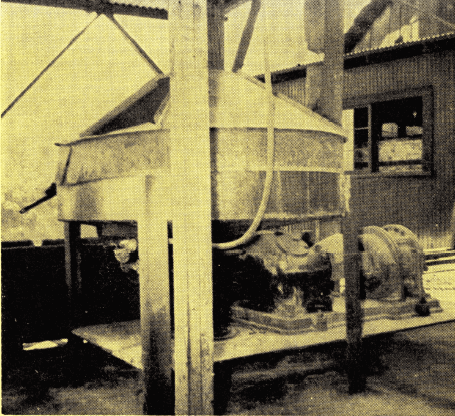
The condensate mud is batch treated in a mechanical hoeing machine. Quicklime is added and with the back-and-forth mixing action of the machine, the mercury is freed, coalesces, and flows to a collecting container placed under the unit. Roughly 85% of the mercury contained in the condensate is recovered by the hoeing machine with the balance being recovered by retorting the residue.
etc. Over four-fifths of the mercury consumed in the United States is used in the form of prime virgin mercury. The remaining one-fifth is further purified and sold under various names for special purposes.
Plant Cleanliness
Special attention is required at all times to prevent the salivation of mill workmen. This consists of adequate ventilation, plant cleanliness, and strict adherence to safety rules. Periodic rotation of the men is also practiced.
Metallurgical Results
Plant recovery figures are not recorded. Past experience has shown that daily sampling of products is not necessary provided the temperature of the furnace gases is maintained in the proper range and close attention is given to the condensing and related operating steps. Under these conditions virtually all the mercury is recovered, and it is meaningless to assay the mill products. The grade of mill feed is determined daily by computing the tonnage treated and dividing it into the pounds of mercury produced during each 24-hour period.
The milling costs range from $5 to $6 per ton. The plant operates seven days per week, 24 hours per day using a total of five men and one additional relief man. The mine operates two shifts per day, six days a week.
